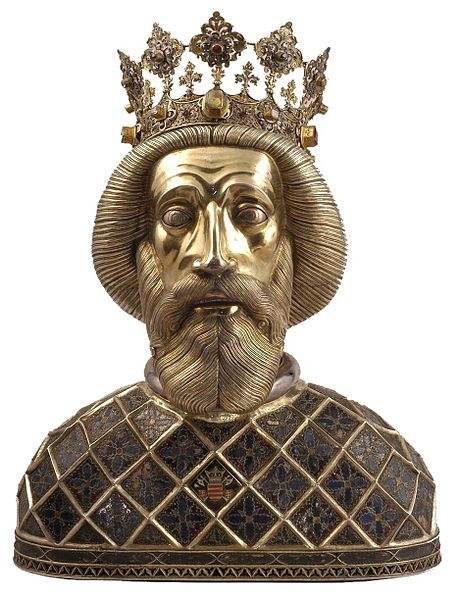St. Ladislaus

Photo of the Reliquary of King Saint Ladislaus I of Hungary by Asybaris01 and located in the Cathedral of Győr.
King of Hungary, born 1040; died at Neutra, 29 July, 1095; one of Hungary’s national Christian heroes. He was the son of Béla I; the nobles, after the death of Geisa I, passed over Solomon, son of Andrew I, and chose Ladislaus to be their king in 1077. It is true that he made peace with Solomon, when the latter gave up all claims to the throne of Hungary; however, later on he rebelled against Ladislaus, who took him prisoner and held in the fortress of Visegrád. On the occasion of the canonization of Stephen I, Ladislaus gave Solomon his freedom, but in 1086 Solomon, with the aid of the heathen Cumans, revolted against Ladislaus a second time; the latter, however, vanquished them, and in 1089 gained another victory over the Turkish Cumans. In 1091 Ladislaus marched into Croatia, at the request of his sister, the widowed Queen Helena, and took possession of the kingdom for the crown of Hungary, where, in 1092, he founded the Bishopric of Agram (Zágráb). In the same year (1092), he also founded the Bishopric of Grosswardein (Nagy-Várad), in Hungary, which, however, some trace back to Stephen I. Ladislaus governed the religious and civil affairs of his assembly of the Imperial States at Szabolcs, that might almost be called a synod. He tried vigorously to suppress the remaining heathen customs. He was buried in the cathedral of Grosswardein. He still lives in the sagas and poems of his people as a chivalrous king. In 1192 he was canonized by Celestine III.
MICHAEL BIHL (Catholic Encyclopedia)

Gentiana cruciata, also called “the herb of Saint Ladislaus” Photo by BerndH. One of the many miracles attributed to the King is this herb. On the occasion of some pestilence in the country, King St. Ladislaus is said to have prayed for the cure before shooting an arrow into the air at random; the arrow then hit this herb, which would cure the illness.
_____________________________
Nobility.org Editorial comment: —
St. Ladislaus is a most worthy example for today’s nobility and analogous traditional elites.
The strict fulfillment of his duties as King of Hungary was no obstacle to his sanctification. He led his people in war and in peace; administered justice and promoted the general welfare; and he died at age 54 amidst preparations to lead the First Crusade.
One can say that he made the Cross of Our Divine Savior the center of his life. He believed, loved, and served the great truths of the Faith. He understood well that this life is a great test where men choose if they are for God or against Him. He believed that life is a constant struggle against the devil, the flesh and the world. He declared for God and thrust himself into the fray with all his heart. And he never looked back.
St. Ladislaus stands in stark contrast against the millions today who have eliminated God and His law from their lives, withholding their adoration from Him in order to give it to the false gods they worship: worldly vanity; avaricious wealth; spiritual and sensual pleasures; comfort and relaxation; a life of superficiality, fun and total lack of responsibility.





